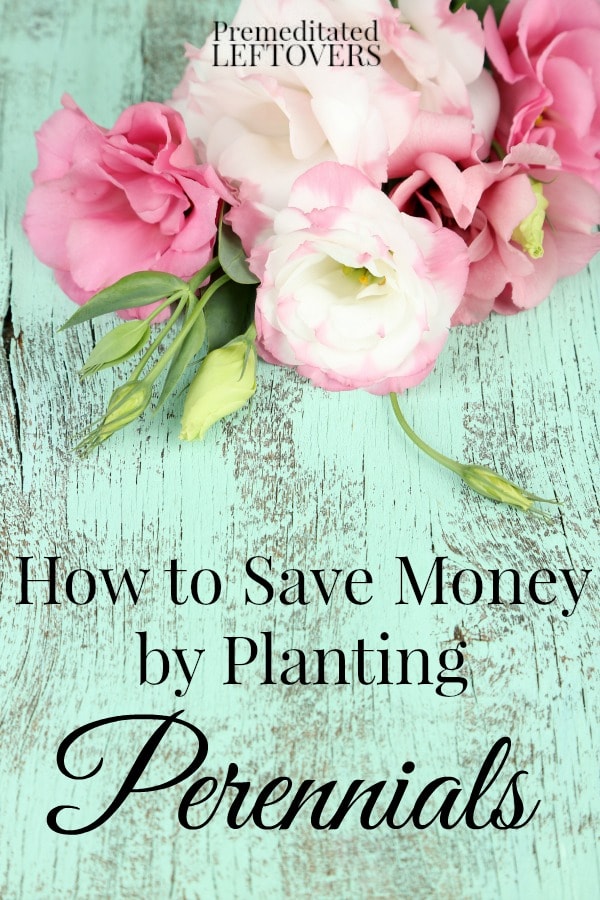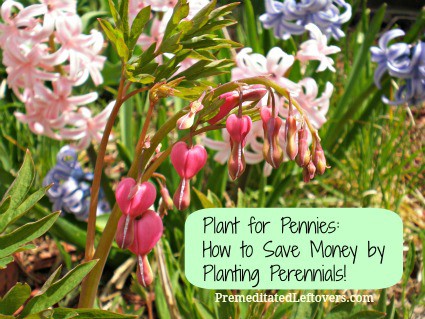Katie shares how to save money by planting perennials instead of annuals:
It took a few years of me visiting the garden center, getting on my knees, planting flower after flower, and ripping them up each fall to realize…it was time to start thinking about perennials! Sure annuals are fresh and colorful, but the task of trying to fill in larger flower beds year after year with them was not only time consuming, but becoming expensive as well. The only problem was, I had no idea where to start. Not knowing a lot about perennials, I had my work cut out for me, or so I thought. But what I found was, you don’t need to be an avid gardener or have the greenest thumb on the block to make perennials work for you. You really can save money (and time) by planting perennials. Take a look at how I did it!
First, here is a quick reminder. “Annuals” are the plants and flowers that you typically buy in flats that need to be planted yearly. An example would be impatiens, petunias, and marigolds. “Perennials” as we are discussing below, are the flowers and plants that return on their own year after year. Examples would be daylilies, roses, and salvia.
How to Save Money by Planting Perennials
1. Pay attention to the plant’s tags.
The great thing about perennials is, they all come with detailed planting tags. These tags tell you exactly how much sun the plant requires and what other factors will help it thrive. Get off on the right foot. Consult these tags before you purchase so you are not buying a plant that is doomed to fail in your yard.
2. Look for native plants.
Native plants are plants that naturally grow in your region. For example in the Midwest, we see tons of Black Eyed Susans, daylilies, and tiger lilies. Because these naturally grow in our area, they know how to thrive with little care. Find out which perennials are natural to your region and you will not only spend less on them than non-native varieties, but they will grow with ease.
3. Stock up on end of season plants.
Come early July, gardening centers mark perennials way down. They might look a little sad, but a little water and fertilizer is all you need to strengthen them for next season. They won’t perform for you this season, but you will only pay about 20% of the original price so it is worth it! Next year they will blow you away with a comeback.
4. Thin out your plants for extra (and free) coverage.
Perennials tend to grow like crazy. They will divide and separate at the bulb and base and before you know it take over! To keep the plant healthy you will need to thin out the blooms at the roots. The great news is, you now have more plants to plant elsewhere in your yard! When you buy a perennial, you not only get yearly growth but additional plants each year.
5. Perennials hold trading value.
If you have perennials, you have an “in” to plant swaps. Plant swaps are held at local gardening clubs, libraries, and other public centers and gardeners love trading extra plants they have for new ones. When you thin out your perennials, save the extra blooms and find a swap or neighbor to trade with. Try doing that with annuals!
Now, let’s crunch some numbers. On average, a flat of annuals will cost you around $10.00. This flat will typically hold about twenty small cells of plants. For your small garden bed, you may need two or three flats to fill it in, spending around $30.00 each year. Instead, you can buy a hardy daylily plant for around $4.00. In that same flower bed, five or six plants would do the trick, costing you around $24.00. Right away, you are spending less! Plus, you daylilies will divide and spread, filling in the space nicely and you won’t need to purchase more flowers the following year. Over five years, you have now saved around $150.00.
Are you convinced yet? Give perennials a try this season and see how much you can save!



magnoliasouth says
I’ve wwo things to say about this:
1. Fair warning: some are super invasive. When my beloved dog Sam passed away, we had him cremated and bought an urn package that had a number of neat things it came with. One of them was a bone shape with wildflower seeds attached to it. Like a piece of tape covered with seed. We planted it, not knowing what it was. Lord have mercy please! Up came these bushes that have very hard stems, no leaves and tiny white flowers. You couldn’t kill these things if you poured gasoline, lit it on fire and then threw more gas on them! They pop up everywhere now. I cut them back and do my best to dig them up and everything else you can imagine but those bad boys are here to stay. It is a serous battle.
2. Look for fruits and vegetables that are perennials and plant those as ornamentals. For example, instead of lining your sidewalk with monkey grass, plant chives. Here’s a good list: http://www.pfaf.org/user/cmspage.aspx?pageid=160 If you have a nice garden awning, use edible perennial vining plants like chayote. Chayote isn’t a great flavored plant, but I’ve found it adds great crunch to salads.
Just my 2¢ worth.
Pauline Wiles says
I actually prefer the look of most perennials over annuals… I think there’s something so lovely about a plant which is ‘happy’ and thriving in its spot, which blooms year after year. It almost feels like the plant equivalent of china versus paper plates 🙂